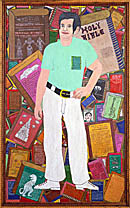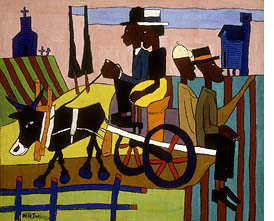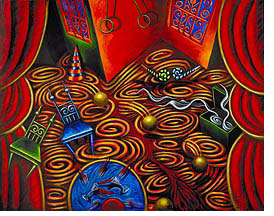Pioneering Collections
Folk Art, African American Art, and Latino Art

The Smithsonian American Art Museum (SAAM) has long championed works that were overlooked by many collectors, museums, and art historians. SAAM was one of the first general museums to recognize the importance of folk art and to display it. The museum significantly increased its folk art holdings when it acquired the renowned Herbert Waide Hemphill Jr. collection and works from the Chuck and Jan Rosenak collection. Howard Finster's painting (shown right) pays tribute to Hemphill, the collector who helped Finster become a folk art celebrity. James Hampton's spiritual sculpture, The Throne of the Third Heaven of the Nations' Millenium General Assembly of the Nations' Millenium General Assembly, a collection highlight, represents the powerful vision of America's self-taught artists. These and works from Thornton Dial Sr., Mr. Imagination, Malcah Zeldis, and others remind us that creativity flourishes independent of formal art training.

In addition, the museum holds a notable array of more than 2,000 works by African American artists. Going to Church (shown left) and many other artworks by William H. Johnson form a key component of the collection. This painting depicts an African American family going from their work in the fields to the spiritual support of the church. Johnson's childhood in rural South Carolina provided a deep wellspring of imagery as he began painting the history, folklore, and spirit of the African American experience. Similarly, artists such as Robert Scott Duncanson, Henry Ossawa Tanner, Horace Pippin, Romare Bearden, Jacob Lawrence, Loïs Mailou Jones, and Sam Gilliam tell stories of the South, the Great Migration, Harlem and the Jazz Age, and the struggle for full acceptance as Americans and as artists.

The museum began actively collecting Latino art about a decade ago. Almost 500 pieces represent rich traditions from colonial religious works to woven textiles. The museum collects artworks by both U.S.-born and immigrant artists, including Puerto Ricans, Mexican Americans and Chicanos, Cuban Americans, and Latin Americans. The museum has acquired paintings and sculptures by contemporary artists such as Carmen Lomas Garza, Patssi Valdez, Carlos Alfonzo, Vik Muniz, and Luis Jiménez. Valdez, a Chicana who grew up in Los Angeles, painted The Magic Room (shown right) and said, "My goal is to keep the paintings alive, to give them a sense of movement." Her painted domestic interiors often function as self portraits—intimate glimpses into internal thoughts and feelings.
Pictured top: Howard Finster, THE HERBERT WADE HEMPHILL J.R. COLLECTION FOUNDER OF AMERICAN FOLK ART THE MAN WHO PRESERVES THE LONE AND FORGOTTEN. THE UNKNOWN COLLECTION., 1978, enamel, 79 1/2 x 50 in., Smithsonian American Art Museum, Gift of Herbert Waide Hemphill Jr. and museum purchase made possible by Ralph Cross Johnson
Pictured middle: William H. Johnson, Going to Church, about 1940–1941, oil on burlap, 38 1/8 x 45 1/2 in., Smithsonian American Art Museum, Gift of the Harmon Foundation
Pictured bottom: Patssi Valdez, The Magic Room,, 1994, oil, 9 x 10 ft., Smithsonian American Art Museum, Museum purchase through the Smithsonian Collections Acquisition Program



